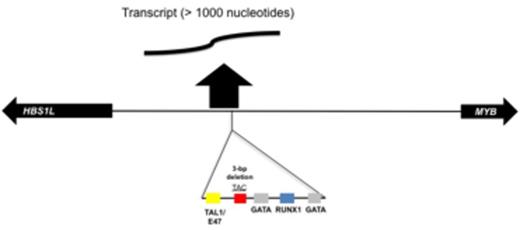Abstract
Fetal hemoglobin (HbF, α2γ2) is the main hemoglobin in the fetus, but its levels decline after birth to <1% in adults. However, there are individuals who continue to have high levels of HbF well into adulthood. High HbF in sickle cell anemia is often associated with milder disease hence the effort to understand more about its regulation for possible therapeutic gain. Some of the variation in HbF among patients with sickle cell anemia can be accounted for by differences in three major HbF quantitative trait loci (QTL) that were found in genome-wide association studies to be associated with high HbF. However, depending on the population studied, these QTLs only account for up to 10-50% of HbF variance. Therefore, determining other factors for high HbF levels is critical in understanding the regulation of HbF expression and finding other possible therapeutic targets to induce HbF production in patients with hemoglobinopathies. Previously, we found that HbF variability is associated with a 3-bp deletion within the HBS1L-MYB intergenic region (Farrell et al, Blood 2011) and this work has been recently confirmed (Stadhouders et al, JCI, 2014). This deletion was found to be in strong linkage disequilibrium (LD) with the QTL HMIP, the HBS1L-MYB intergenic region on chr6q23. Functional analyses of the region around the 3-bp deletion using ChIP assay in K562 cells, which are heterozygous for the 3-bp deletion, found that four transcription factors that are involved in erythroid cell differentiation—GATA-2, TAL1, E47 and RUNX1—all bind in the region of the 3-bp deletion. ENCODE datasets show that RNA polymerase II and a 50 bp RNA transcript are found in this same area. Based on these observations, we set out to determine the extent of the 50-bp transcript found by ENCODE. Using cDNA from K562 cells and the 50-bp transcript as a guide, we were able to amplify by PCR a fragment greater than 1 kb, which includes the 3-bp deletion and the binding sites for the erythroid-specific transcription factors mentioned above. Sequencing of this PCR product confirmed that the transcript is transcribed from the HBS1L-MYB intergenic region. Next, 5'- and 3'-rapid amplification of cDNA ends (RACE) reactions were done to determine the full length of this transcript. Sequencing results of the RACE products show that the 3'-end of the transcript is more than 100 bp downstream from what was originally found by PCR. Results for the 5'-end are pending. By knowing the sequence of this transcript, we were able to make multiple transcript-specific primers and use them in qPCR to determine if expression of this transcript changes with induction of hemoglobin synthesis in K562 cells. Preliminary data show after the induction of HBG2 expression with butyrate, various areas of this novel transcript increased as well. Because globin synthesis in K562 cells is fixed at the fetal stage of development we also looked for expression of this transcript in iPSC-derived erythroid progenitor cells from a disease-free individual and an individual with sickle cell anemia on day 25 of differentiation, and in CD34+ cord blood-derived erythroid cells on days 7 and 14 of differentiation. qPCR showed that in these primary erythroid cells the transcript is expressed at similar levels as in K562 cells. This novel transcript within the HBS1L-MYB intergenic region seems to increase with hemoglobin induction in K562 cells, and is also found in other primary erythroid cells derived from iPSCs and CD34+ cells. This transcript is a candidate for being a long noncoding RNA (lncRNA). LncRNAs are transcripts of 200 nucleotides or greater that can be transcribed from any region of the genome. They have been shown to be involved in gene regulation and various biological processes including hematopoiesis. HMIP has a primary effect on hematopoiesis. As this fragment is transcribed from a region known to be associated with HbF variability, it will be of interest to determine its role in HbF expression.
No relevant conflicts of interest to declare.
Author notes
Asterisk with author names denotes non-ASH members.


This feature is available to Subscribers Only
Sign In or Create an Account Close Modal